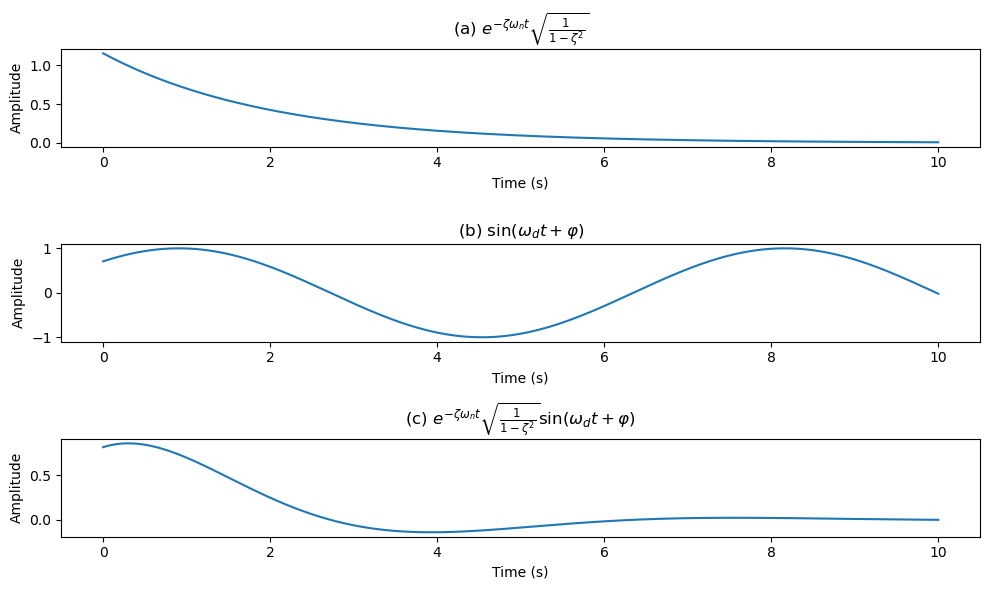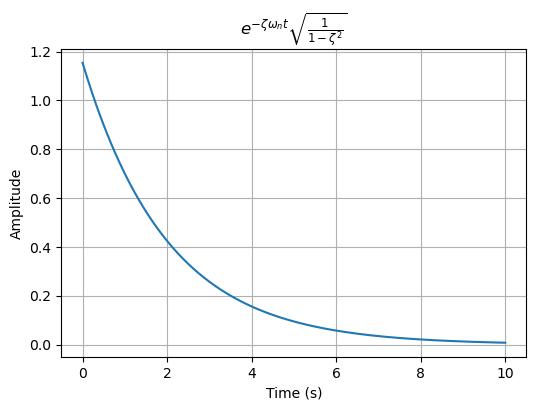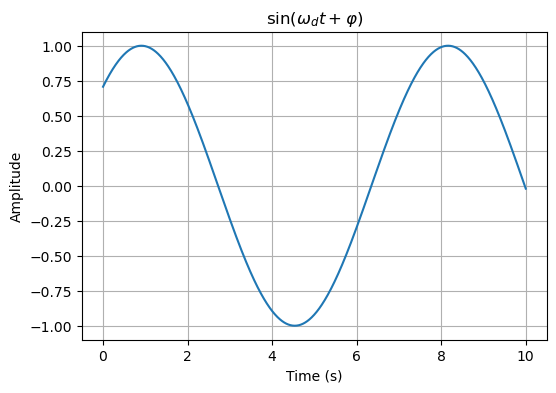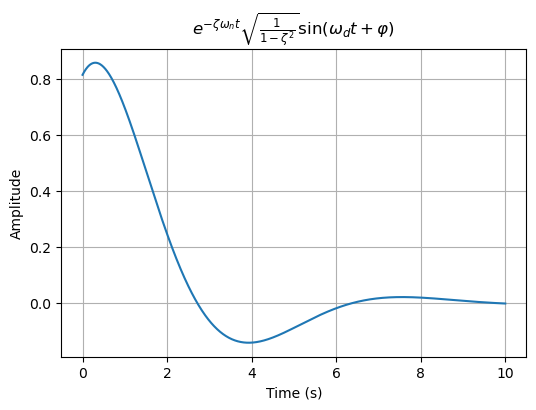![image]()
import numpy as np
import matplotlib.pyplot as plt
# 定义参数
zeta = 0.1 # 阻尼比减小,以实现更慢的衰减
omega_n = 1.0 # 自然频率
omega_d = omega_n * np.sqrt(1 - zeta**2) # 阻尼频率
varphi = np.pi / 4 # 相位角
# 定义时间变量
t = np.linspace(0, 20, 2000) # 从0到20秒,2000个点,增加周期
# 计算函数值
a = np.exp(-zeta * omega_n * t) * np.sqrt(1 / (1 - zeta**2))
b = np.sin(omega_d * t + varphi)
c = np.exp(-zeta * omega_n * t) * np.sqrt(1 / (1 - zeta**2)) * np.sin(omega_d * t + varphi)
# 绘制图像
plt.figure(figsize=(15, 5)) # 设置整个图像的大小
# 绘制(a)部分
plt.subplot(1, 3, 1) # 1行3列的第1个
plt.plot(t, a)
plt.title(r'(a) $e^{-\zeta\omega_{n} t}\sqrt{\frac{1}{1-\zeta^2}}$')
plt.xlabel('Time (s)')
plt.ylabel('Amplitude')
plt.grid(True)
# 绘制(b)部分
plt.subplot(1, 3, 2) # 1行3列的第2个
plt.plot(t, b)
plt.title(r'(b) $\sin(\omega_{d} t+\varphi)$')
plt.xlabel('Time (s)')
plt.ylabel('Amplitude')
plt.grid(True)
# 绘制(c)部分
plt.subplot(1, 3, 3) # 1行3列的第3个
plt.plot(t, c, label='Damped Sine Wave')
plt.plot(t, a, label='Envelope', linestyle='--') # 绘制包络线
plt.title(r'(c) $e^{-\zeta\omega_{n} t}\sqrt{\frac{1}{1-\zeta^2}}\sin(\omega_{d} t+\varphi)$')
plt.xlabel('Time (s)')
plt.ylabel('Amplitude')
plt.legend()
plt.grid(True)
# 显示图像
plt.tight_layout() # 调整子图间距
plt.show()
![image]()
import numpy as np
import matplotlib.pyplot as plt
# 定义参数
zeta = 0.5 # 阻尼比
omega_n = 1.0 # 自然频率
omega_d = omega_n * np.sqrt(1 - zeta**2) # 阻尼频率
varphi = np.pi / 4 # 相位角
# 定义时间变量
t = np.linspace(0, 10, 1000) # 从0到10秒,1000个点
# 计算函数值
a = np.exp(-zeta * omega_n * t) * np.sqrt(1 / (1 - zeta**2))
b = np.sin(omega_d * t + varphi)
c = np.exp(-zeta * omega_n * t) * np.sqrt(1 / (1 - zeta**2)) * np.sin(omega_d * t + varphi)
# 绘制图像
plt.figure(figsize=(10, 6))
# 绘制(a)部分
plt.subplot(3, 1, 1)
plt.plot(t, a)
plt.title(r'(a) $e^{-\zeta\omega_{n} t}\sqrt{\frac{1}{1-\zeta^2}}$') # 使用r前缀来表示原始字符串
plt.xlabel('Time (s)')
plt.ylabel('Amplitude')
# 绘制(b)部分
plt.subplot(3, 1, 2)
plt.plot(t, b)
plt.title(r'(b) $\sin(\omega_{d} t+\varphi)$') # 使用r前缀来表示原始字符串
plt.xlabel('Time (s)')
plt.ylabel('Amplitude')
# 绘制(c)部分
plt.subplot(3, 1, 3)
plt.plot(t, c)
plt.title(r'(c) $e^{-\zeta\omega_{n} t}\sqrt{\frac{1}{1-\zeta^2}}\sin(\omega_{d} t+\varphi)$') # 使用r前缀来表示原始字符串
plt.xlabel('Time (s)')
plt.ylabel('Amplitude')
# 显示图像
plt.tight_layout()
plt.show()
![image]()
import numpy as np
import matplotlib.pyplot as plt
# 定义参数
zeta = 0.5 # 阻尼比
omega_n = 1.0 # 自然频率
omega_d = omega_n * np.sqrt(1 - zeta**2) # 阻尼频率
varphi = np.pi / 4 # 相位角
# 定义时间变量
t = np.linspace(0, 10, 1000) # 从0到10秒,1000个点
# 计算函数值
a = np.exp(-zeta * omega_n * t) * np.sqrt(1 / (1 - zeta**2))
b = np.sin(omega_d * t + varphi)
c = np.exp(-zeta * omega_n * t) * np.sqrt(1 / (1 - zeta**2)) * np.sin(omega_d * t + varphi)
# 绘制(a)图
plt.figure(figsize=(6, 4))
plt.plot(t, a)
plt.title(r'$e^{-\zeta\omega_{n} t}\sqrt{\frac{1}{1-\zeta^2}}$')
plt.xlabel('Time (s)')
plt.ylabel('Amplitude')
plt.grid(True)
plt.show()
# 绘制(b)图
plt.figure(figsize=(6, 4))
plt.plot(t, b)
plt.title(r'$\sin(\omega_{d} t+\varphi)$')
plt.xlabel('Time (s)')
plt.ylabel('Amplitude')
plt.grid(True)
plt.show()
# 绘制(c)图
plt.figure(figsize=(6, 4))
plt.plot(t, c)
plt.title(r'$e^{-\zeta\omega_{n} t}\sqrt{\frac{1}{1-\zeta^2}}\sin(\omega_{d} t+\varphi)$')
plt.xlabel('Time (s)')
plt.ylabel('Amplitude')
plt.grid(True)
plt.show()
![image]()
![image]()
![image]()








 浙公网安备 33010602011771号
浙公网安备 33010602011771号